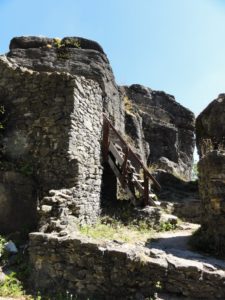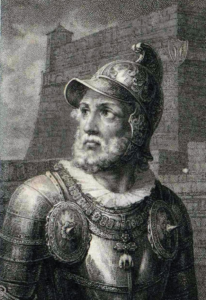Szitnya

Szitnya Castle is crowning the top of the huge Szitnya Hill above the village of Illés (Ilija), it is only four kilometers away from the rich mining town, Selmecbánya (Banská Štiavnica). It is located in the Upper Lands/Horná zem/Felvidék, in Slovakia.
Here is a video about it: https://www.youtube.com/watch?v=dn5sOmYIRvY

It takes one and a half hours to climb the steep path that is leading to the castle which is one of the highest built forts of the Upper Lands. The view is magnificent from 1009 meters although the walls and the buildings of the inner and the lower castles have been mostly ruined by the forces of nature and by human destruction. The old Royal Hungary used to have 72 counties but from the summit, one could see 18 of them, from the blue line of the Danube up to the snowy Tátra Mountains of the immense Carpathians.

The fortress was divided into a lower and a higher castle. The servants and the soldiers used to live in the lower castle and stairs were carved into the steep cliffs that led up to the inner castle’s tower where the lord of the fortress lived with his family.

It is not recorded who built Szitnya Castle but it is assumed that it was built after the Mongolian Invasion of 1241-42 when King Béla IV was feverishly rose castle after castle in fear of the horse-archer nomads. Szitnya’s role was to defend the area of the Mining Towns District of Upper Hungary, the area that supplied Europe with huge quantities of gold and silver. Here is more about the mining Towns of Hungary:
https://www.hungarianottomanwars.com/essays/the-mining-towns-of-upper-hungary/

The village of the castle can boast a church built in the first part of the 13th century in Romanesque style. Inside, you can see statues from the 14th century and its altar is from the 17th century. Its Gothic paintings are treasured in the Museum of Túrócszentmárton.
The owners of the castle from the early centuries are not listed anywhere. All we know is, that the high-ranked Lévai Cseh family became its owner before 1542. Baron Lévai Cseh Gábor lost his life while defending the city of Pest against the Turks in 1542 and his only son, János inherited Szitnya Castle. (Please, note that I use the Oriental name order for Hungarians where family names come first.)

The infamous but valiant robber knight, Balassa Menyhárt, got Szitnya Castle by marriage. He was the uncle of the most famous Hungarian poet-warrior of the Renaissance, Balassa Bálint. Lord Balassa Menyhárt was a renowned warrior, his father fell in the Battle of Mohács in defense of the king. He defended the Castle of Léva from the night attack of the Turks in 1544 and then he helped the hussars of Nyáry Ferenc and Thury György to defeat the Turks at the city of Szalka, on the bank of the Iploy River. A heroic song was composed about Balassa’s victory at Szalka by the greatest troubadours of the age, Tinódi Lantos Sebestyén.

He also became the lord of Léva and Csábrág castles at the same time. Lord Balassa was appointed by King Ferdinand I as Comes of Bars County as well. However, he was not satisfied with the king and tried to take advantage of the unstable situation of the kingdom. From time to time he pillaged and robbed the properties of the petty nobility in the area, claiming they were not loyal to the king. When he robbed the gold plates carried from Selmecbánya, he was reasoning that he needed the money to fight the Turks. Finally, the Habsburg king had had enough of him and he ordered the arrest of Balassa in 1549. You can read more about him here:
General Nikolaus Salm, the Chief Captain of Hungary was sent against him with almost 6,000 men. Salm’s second task was to fight another robber knight called Basó Mátyás who was the lord of the Tiszolc and Murány castles, too. The General laid a siege on Léva, Szitnya, and Csábrág castles and took them one by one.

Lord Balassa was smart enough not to defend his forts in person but he left for Transylvania, giving the command over Szityna Castle to Captain Makri Lukács. The Captain was heroically defending the fort on the steep cliff and repelled the assault of the Habsburgs’ Spanish mercenaries. According to the records, there were 300 Spanish troops, led by Ebestorf and his subordinate, Horvátinuvity. The besiegers lost seven infantrymen, and one artilleryman, and twenty-five soldiers were injured on the first day. A Hajdú Captain, Bak Orbán, tried to relieve Szitnya Castle by attacking the Spanish mercenaries with his 100 Hajdú soldiers but he and 56 of his men were captured by Horrvátinuvity. You can read more about the Hungarian Hajdú soldiers here:
https://www.hungarianottomanwars.com/essays/the-hungarian-hajdu-warriors/

Seeing the reinforcement defeated, the defenders made Captain Makri surrender the eagle’s nest under the term of receiving a pardon. The Hungarians were free to go and they left Szitnya Castle. They were more than welcome in other places of the Borderland to fight the Turks. Salm’s men did not destroy the castle because they thought it would serve them well against the raiding Turks.
Szitnya remained part of the castle chain that protected the Mining Towns but it was never rebuilt to withstand the more advanced artillery weapons of the age.

The Turks were visiting the area because they wanted to get access to the gold and silver mines, they destroyed the village of Szitnyatő right below the castle in 1571. Szitnya was in the hands of the Illésházy and the Pálffy families but somehow, the Balassa family always regained ownership over the castle. Finally, Lady Balassa Borbála married the wealthy Koháry Péter in 1629.
Szitnya Castle was not in the best condition in the time of Prince Thököly Imre between 1678 and 1683 when it was defended by the rebel troops against the Emperor’s army.

The last soldiers in the castle were the Germans of the Emperor during the War of Independence of Prince Rákóczi Ferenc in the first decade of the 18th century. When they heard the approach of General Ocskay László’s rebels, the mercenaries hastily had the whole castle exploded before running away. When the wars ceased to blacken the ruins anymore, the first sightseeing tower in Hungary was built on top of them in 1727.

Dear Readers, I can only make this content available through small donations or by selling my books or T-shirts:
Please, feel free to support me with a coffee here:
You can check out my books on Amazon or Draft2Digital, they are available in hardcover, paperback, or ebook:
https://www.amazon.com/dp/198020490X or at https://books2read.com/b/boYd81

My work can also be followed and supported on Patreon: Become a Patron!http://Become a Patron!
[wpedon id=”9140″]

https://hungarianottomanwars.myspreadshop.com/all
















